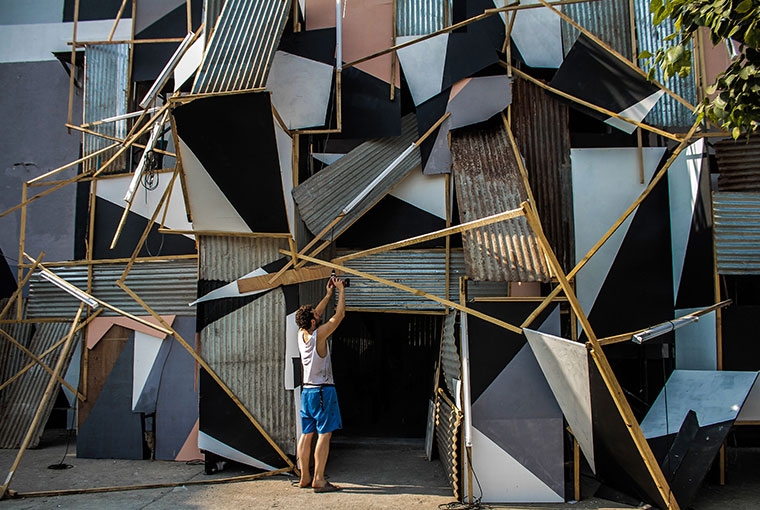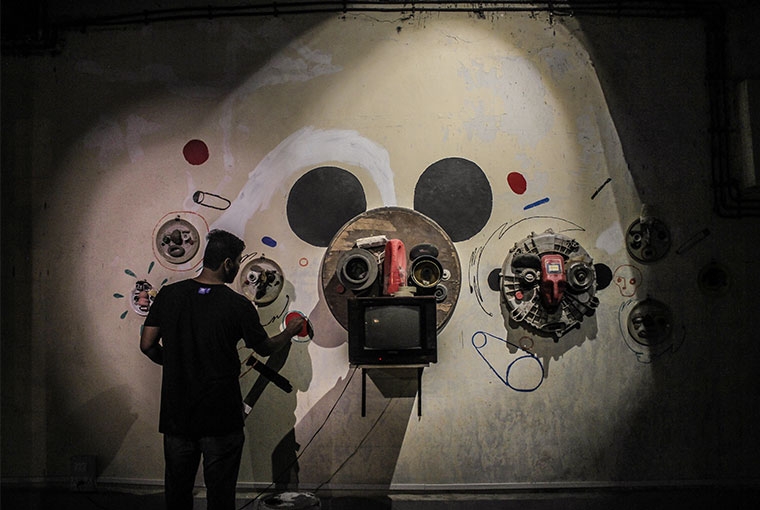
Artist: Curiot and Romina Romanelli. Photography by Akshat Nauriyal.

Artist: Curiot and Romina Romanelli. Photography by Akshat Nauriyal.
The internet has been exploding with photographs of art installations and breathtaking life-sized murals as the #SassoonDockArtProject comes to life in Colaba, Mumbai. A part of the the Urban Art Festival 2017 being organised by St.Art Mumbai – an organisation that has been on the forefront of the street art revolution in India for a while, the Sassoon Dock Art Project is a public dock art exhibition that opened its gates to the people of the city on 11th November, 2017.
An initiative meant to strengthen the street art culture in our country and bring back lost spaces, like the Dock itself, the festival is a platform to create, curate and interact—not just for the artists but for the public too. In a city where people barely have the time to stop and breathe, the Urban Art Festival 2017 is compelling people to take a step back and absorb art like never before.
We speak to Hanif Kureshi, the Co-founder and Creative Director of St.Art India Foundation, about the festival and what it’s like to watch an entire city turn into a giant canvas.
St.Art’s Urban Art Festival 2017 is back in Mumbai for the second time. What is the intention behind it?
The Urban Arts Festival had its first edition in 2014. We’ve had six editions previously in cities across the country—Delhi, Mumbai, Hyderabad, Bengaluru. And now Mumbai again. The foundation of the festival lies in making art more common and separating it from the commercial aspect of it. People shouldn’t feel like art is some sort of luxury meant only for the elite. It should be more accessible for anyone and everyone. The Urban Arts Festival is trying to bring about this change by making art more accessible.

Clemens Behr
How did you curate the artist lineup for the festival?
We have selected a mix of international as well as national artists. We have artists who have been in the street art scene for a while and some who have never experimented with this art form. Having both kinds on board is an opportunity for the artists to interact and grow.
Brazilian street artist called Eduardo Kobra is the man behind the Mahatma Gandhi mural at the Churchgate station which is one of Mumbai’s busiest stations.
Apart from Sassoon Docks, which are some other locations and why have they been chosen?
Some of the other locations chosen are Mahim East (Dharavi), Churchgate, and Jindal Mansion. Our reasons for choosing the location is different for each site. We wanted locations where the past and the present of Mumbai came together. Like Dharavi is very much the present of Mumbai and Sassoon Docks are, in a way, the past. These locations collectively show a journey of Mumbai–from where it started to where it has come today.
What challenges did you while setting up the docks?
A project of this scale has its own challenges. Hygiene, for instance, is a major concern. Then of course, getting permissions. We’ve been working on permissions since almost a year. Also, many people have never really visited the docks so to get them to visit the place and see the art installations is a milestone we hoped to achieve.
The festival has organised multiple art projects over the years—what has the response been like? Is it growing?
The response is huge. Our first edition was in Delhi, in a village called Shahpura. We had to go knocking from one door to another and tell people about the festival. Today things are very different. We have the support of the state and central government, local bodies, media organisations, locals, artists etc. We’ve been across the country so people know about the festival. All of these people supporting us have understood the importance of this art form.

Hi by Sajid Wajid. Photography by Pranav Gohil.
What is next in the Street Art revolution in India?
I think street art in India has come a long way. From a time when nobody knew what street art even meant till today–we’re celebrating an entire festival based around this movement. I think it’s quite an achievement. There’s now a commercial demand for street art in the form of wall art in cafes and stores. People are starting to understand and accept it; it’s becoming a part of the mainstream culture. It’s not exactly a trend but the demand for it has definitely increased, especially in the last couple of years.
There is no comparison between street art in the world and street art in India. The purposes of both are very different. Internationally, street art may be used for, say, raising awareness or sponsorship. In India, we don’t do that.
Your favourite bit about the festival?
I’m looking forward to opening up Sassoon docks to the people; opening up a different side of Mumbai for its people. Even though it’s surrounded by a number of galleries, in the art hub of the city, yet people have never visited the docks.
What is the thought process behind the iconic Mahatma Gandhi mural at the Chruchgate station?
If you go back in history, you’ll find that there’s a very iconic photo of Gandhi getting off a train. It’s quite an iconic image. The freedom struggle can also be traced back to when Gandhi was kicked off a train for being an Indian. So the connection was right there. Gandhi at a railway station..the beginning of the freedom struggle..it just made sense.
What has St.Art planned next?
We’re going to be in Hyderabad from 1-15 December for St.Art Hyderabad, after that St.Art will be in Goa for the Serendipity Arts Festival. In January, we will be in Kolkata and February in Chandigarh.
St.Art Mumbai 2017 Urban Arts Festival is supported by Asian Paints.
Text Pankhuri Shukla